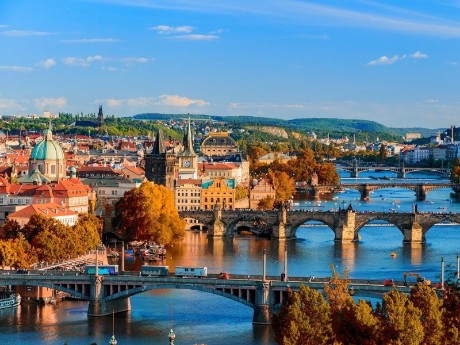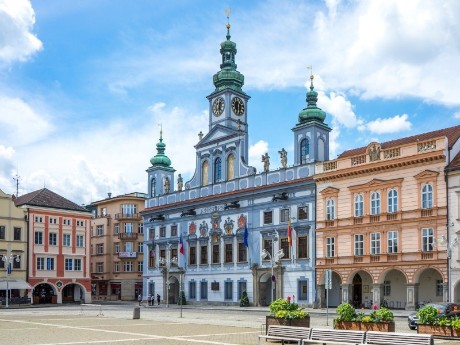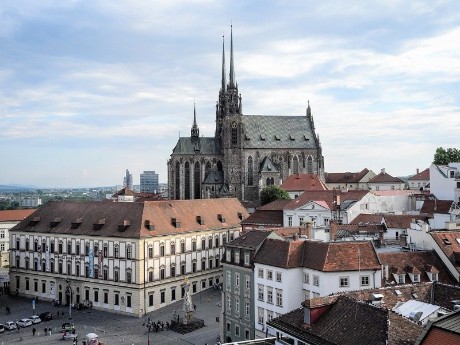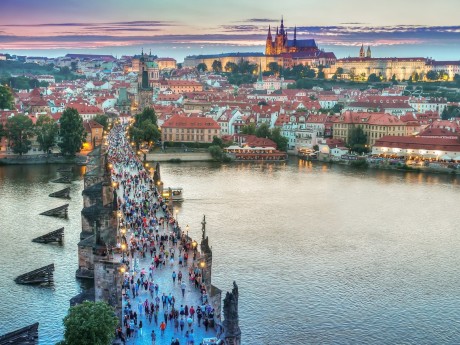Czech Republic: Prague, Český Budejovice & Brno
Historic Charles Bridge, wonderous Moravian Karst, beautiful gardens, fountains, royal castles, and world-famous towns. Start in Prague, the capital of Czech Republic. Visit the Prague Castle built in the 9th century and the official office of the country's President. Prague's Old Town Square, built in the 10th century along with Charles Bridge are must see attractions. St. Vitus Cathedral, the largest and most important church in the country, used for coronations of Czech monarchs.
Read more
Historic Charles Bridge, wonderous Moravian Karst, beautiful gardens, fountains, royal castles, and world-famous towns. Start in Prague, the capital of Czech Republic. Visit the Prague Castle built in the 9th century and the official office of the country's President. Prague's Old Town Square, built in the 10th century along with Charles Bridge are must see attractions. St. Vitus Cathedral, the largest and most important church in the country, used for coronations of Czech monarchs. Next, in Český Budejovice, a city famous for its beer. The Baroque style Samson fountain sits in the city centre with the 16th century Black Tower overlooking it. However, the city's most impressive attraction is the State Chateau of Hluboká with its snow white facade, intricate design and gorgeous garden. Lastly, in Brno, start with Špilberk Castle, which stands out for its famous dungeon and amphitheatre. Náměstí Svobody, the historic town square, also impresses with iconic buildings and sculptures, and Moravian Karst close by is a series of hundreds of caves with canyons, underground streams and cliffs. Waterviews offers hotels within walking distance to water and optional activities via our “Add Activities’’ button in our booking page. All Prices include taxes and Hotel charges are on a per room basis. To customize this trip to your personal preferences, contact us at : Service@waterviews.ca.
Destinations
- Prague
- České Budějovice
- Brno
Itinerary
Prague

Set on the banks of the flowing Vltava River, enchanting Prague prides itself as the Czech Republic's capital and largest city. From the countless towering spires of the city’s historic churches and the cobbled streets and majestic squares of its magical Old Town to its excellent museums, world-renowned breweries and vibrant cultural scene, Prague offers something for everyone. Be sure to stroll along the medieval Charles Bridge and take in the views of the city's incredible 9th century castle - you won't be disappointed.
Read more
Set on the banks of the flowing Vltava River, enchanting Prague prides itself as the Czech Republic's capital and largest city. From the countless towering spires of the city’s historic churches and the cobbled streets and majestic squares of its magical Old Town to its excellent museums, world-renowned breweries and vibrant cultural scene, Prague offers something for everyone. Be sure to stroll along the medieval Charles Bridge and take in the views of the city's incredible 9th century castle - you won't be disappointed.
Additional Information
This city of bridges, cathedrals, gold-tipped towers and church domes, has been mirrored in the surface of the swan-filled Vltava River for more than ten centuries. Almost undamaged by World War II, Prague's compact medieval centre remains a wonderful mixture of cobbled lanes, walled courtyards, cathedrals and countless church spires all in the shadow of her majestic 9th century castle that looks eastward as the sun sets behind her. Prague is also a modern and vibrant city full of energy, music, cultural art, fine dining and special events catering to the independent traveller's thirst for adventure.
It is regarded by many as one of Europe's most charming and beautiful cities, Prague has become the most popular travel destination in Central Europe along with Budapest and Kraków. Millions of tourists visit the city every year.
Prague was founded in the later 9th century, and soon became the seat of Bohemian kings, some of whom ruled as emperors of the Holy Roman Empire. The city thrived under the rule of Charles IV, who ordered the building of the New Town in the 14th century - many of the city's most important attractions date back to that age. In 1348 Prague became an university town, which it has remained ever since. The University, which is sometimes claimed to be the oldest in Central Europe was split into a German and a Czech language part in 1882 with the German language part shut down in 1945, thus ending the claim of "oldest German university" Prague might have reasonably held until then. The city also went under Habsburg rule and became the capital of a province of the Austro-Hungarian Empire. It had a German-speaking majority well into the 19th century, and even after then, maintained a significant German-speaking minority until the expulsion of ethnic Germans from Czechoslovakia following World War II. During that period, Prague would give rise to several prominent German-language authors, perhaps the most notable being Franz Kafka, known for works such as Die Verwandlung (The Metamorphosis) and * Der Process* (The Trial). In 1918, after World War I, the city became the capital of Czechoslovakia. After 1989 many foreigners, especially young people, moved to Prague. In 1992, its historic centre was inscribed on the UNESCO World Heritage List. In 1993, Czechoslovakia split into two countries and Prague became capital city of the new Czech Republic.
The Vltava River runs through Prague, which is home to about 1.2 million people. The capital may be beautiful, but pollution often hovers over the city due to its location in the Vltava River basin.
Climate
|source 2 # NOAA |date = July 2018 }} Prague has a humid continental climate, with relatively cold winters (about freezing point). Snow cover occurs between mid-November and late March. The snow cover rarely stays around for more than a week or two. Summers usually bring plenty of sunshine and the average high temperature of . Precipitation in Prague is rather low, driest season usually being the winter. During late spring and summer heavy rain may occur, often in a form thundershowers. Temperature inversions are relatively common around winter, bringing foggy, cold days and sometimes moderate air pollution. Prague is a windy city with common sustained western winds and an average wind speed of .
Chaty
Many Praguers have a small cottage (which can range from a shack barely large enough for garden utensils to an elaborate, multi-story dwelling) outside the city. There they can escape for some fresh air and country pursuits such as mushroom hunting and gardening. These cottages, called chata (plural form chaty, pronunciation of ch as in Bach), are treasured both as getaways and ongoing projects. Each reflects its owner's character, as most of them were built by unorthodox methods. Chata owners used the typically Czech "it's who you know" chain of supply to scrounge materials and services. This barter system worked extremely well, and still does today. Chaty are also sometimes used as primary residences by Czechs who rent out their city-centre apartments for enormous profit to foreigners who can afford to pay inflated rent.
© Sourced from Wikivoyage
České Budějovice

The capital of South Bohemia, České Budějovice makes for an excellent overnight stop filled with history and culture. Meander through the grand main square, stroll along the cobbled streets of the Old Town and be sure to sample a world-renowned Budvar beer on a tour of the local brewery. České Budějovice also makes an excellent base for visiting the highlights of the region, with historic Český Krumlov and the village of Holašovice only a short journey away.
Read more
The capital of South Bohemia, České Budějovice makes for an excellent overnight stop filled with history and culture. Meander through the grand main square, stroll along the cobbled streets of the Old Town and be sure to sample a world-renowned Budvar beer on a tour of the local brewery. České Budějovice also makes an excellent base for visiting the highlights of the region, with historic Český Krumlov and the village of Holašovice only a short journey away.
Additional Information
This South Bohemian metropolis was founded in 1265 by the Czech King Premysl Otakar II on the confluence of the Vltava and Malse Rivers. The Square of Premysl Otakar II is 133 m by 137 m, and is one of the largest squares in Bohemia. It has arcades and a range of Gothic, Renaissance and Baroque burgher's houses. The other important town monuments include the Town Hall, the Samson's fountain and the 72 metre-high Black Tower which provides a beautiful view of the town and surroundings.
The town is an excellent place to visit if you want to escape the large numbers of tourists in Prague or nearby Český Krumlov. Its well-developed transport links make it the perfect base from which to explore the surrounding region. There are many historic towns and villages nearby, numerous hiking trails, and a vast cycle path network. The most famous cycle path is No. 12 which connects České Budějovice and Hluboká nad Vltavou.
© Sourced from Wikivoyage
Brno

The capital of Moravia and the Czech Republic's second-largest city, Brno is a vibrant hub of culture and history that is well worth the visit on any trip to the region. From the towering hilltop Cathedral to the modern Villa Tugendhat, the city's seamless blend of old and new only adds to its appeal. Days in Brno can be spent strolling through the historic streets and bustling squares of the Old Town, meandering in excellent museums and relaxing in the city's countless trendy cafes and bars.
Read more
The capital of Moravia and the Czech Republic's second-largest city, Brno is a vibrant hub of culture and history that is well worth the visit on any trip to the region. From the towering hilltop Cathedral to the modern Villa Tugendhat, the city's seamless blend of old and new only adds to its appeal. Days in Brno can be spent strolling through the historic streets and bustling squares of the Old Town, meandering in excellent museums and relaxing in the city's countless trendy cafes and bars.
Additional Information
The city was founded about 1000 years ago, it received city status in the year 1243, and for centuries it served as the capital city of Moravia, until 1948 when communists abolished autonomy of Moravia. The city flourished mainly during the 19th century. Today's Brno is a mixture of many different architecture styles, there are many beautiful places. But still, it's a home to great culture, and countless beautiful buildings, the city has the third largest historic preservation zone in the country (the biggest one is in Prague, the second largest is in Olomouc). There are three castles, Špilberk (former royal castle, and former seat of rulers of Moravia), Veveří castle (near the Brno dam lake), and the Líšeň Castle.
Brno is not particularly well known by tourists so you can easily avoid crowds and overpriced services.
Brno is the cultural hub of Moravia, it's the home to a number of notable Moravian institutions, e.g. Moravian Gallery, Moravian Museum, National Theatre Brno, and Brno City Theatre. It's a city with a long tradition in motor racing (on the Masaryk Circuit), huge exhibitions and trade fairs (in the Central European Exhibition Center), and as vibrant university city. There are about 89,000 university students in Brno, a city with 380,000 inhabitants, it makes it the country's largest student city by percentage of population. Since 1998, there is also an international firework competition held annually at the end of May and beginning of June - Ignis Brunensis, it attracts about 100,000-200,000 visitors every day it's being held.
The most interesting places in Brno includes the Brno Underground, a labyrinth of underground cellars which includes the second biggest ossuary in Europe (after the Catacombs of Paris), the two (or three) castles in Brno, the cathedral on the Petrov hill (Pope Benedict XVI. visited the cathedral in 2009), the Basilica of the Assumption of Our Lady in the Old Brno District, the St. Jacob's Church, the Moravian Museum (the biggest museum in Moravia and the second biggest in the country), Lužánky Park which is the oldest public park in the country, Denis Gardens, and various historical squares, churches, palaces, and other interesting buildings.
There are also many places which might be worthy of visit outside of the city centre, like an old Jewish cemetery in Brno-Židenice (by area, the biggest one in Moravia), or the Marian Valley in Brno-Líšeň, it's which is a cascade of lakes between forested hills. From the north, Brno is surrounded by hills and very pleasant nature, probably the most notable place is the Moravian Karst.
Brno lost its status of the capital city but it still behaves like a "cosmopolitan" capital, there is a rich variety of various cultural events, clubs, pubs, etc., and several excellent museums and theatres. Also there are two interesting things about theatres in Brno, Reduta Theatre is the oldest theatre building in Central Europe, and Mahen Theatre (part of the National Theatre Brno) is the first theatre in the entire Europe which was illuminated by Thomas Edison's electric light bulbs (in that time, it was only a four-year-old invention). Brno also serves as the capital of judicial authority of the Czech Republic (it's the seat of the Constitutional Court, the Supreme Court, the Supreme Administrative Court) and many other state authorities, the rest of it is located in Prague.
Tourist information
© Sourced from Wikivoyage





